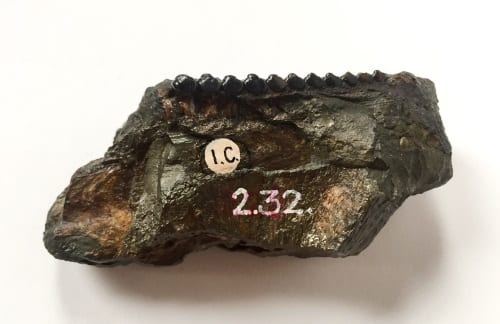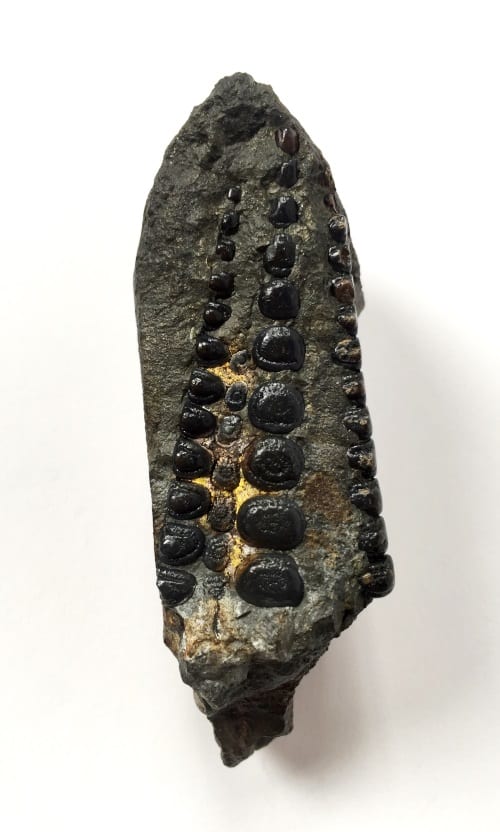Underwhelming Fossil Fish of the Month: August 2016
By Mark Carnall, on 31 August 2016
August is typically the month that people occupy themselves with science until the sports season begins again in the autumn. In fact the word summer comes from the Proto-Germanic sumur which roughly translates as ‘the season in which we do not occupy ourselves with sports but instead spend a lot of time doing science’* So with so many people doing science this summer, and who aren’t engaged in sport or watching or thinking about sport, I’m hoping that we can fulfil the mission of this blog post series. The humble mission of this monthly blog series featuring underwhelming fossil fish from the Grant Museum collection is:
all I’m asking you to do is look at it, observe it, take some time to ponder upon it and perhaps tell a friend about it. Together we’ll increase the global fossil fishteracy one fossil fish at a time.
Regular readers of this series will know that this isn’t sell-out science. There’s no record breakers here. All we have is a rather dull fossil fish to contemplate. Will we learn something? Probably not. Will it pass the time? Depends how fast you read I guess. So without further ado, loosen your belt of expectation and let’s see this month’s fragmented fossil fish.

LDUCZ-V1720 Gyrodus cuvieri. Don’t let the unusually high standard of photography lure you into a false sense of whelmingness.
Although this fossil looks good enough to eat, don’t let the uncharacteristically high quality photography sway you. This is still and underwhelming fossil fish at heart. According to the ever reliable label information for this specimen, this is a part of the jaw with teeth of Gyrodus cuvieri, a species in the, fan-favourite actinopterygian family, pycnodontidae. This specimen was reportedly collected from the Kimmeridge Clay Formation although the precise collection locality is unknown and is labelled with an old Imperial College London number, indicating that this specimen was there before being transferred to UCL in the 1980s.
Gyrodus fish fossils are found in Jurassic and Cretaceous deposits, and are completely unremarkable in that they look like very typical fish. This may explain the brevity of the Wikipedia sentence for this genus and this curious page on the University of Leicester website comparing Gyrodus to a sheepshead seabream in a vain attempt to say something about them.

LDUCZ-V1720 Gyrodus cuvieri. Check out the rows of teeth on that one! Again, don’t be fooled by the whelming images.
Preservation It is easy to be mislead by the C&A catalogue quality photography, however, this is one of the better preserved rows of teeth we’ve had in this blog series. Comparing this specimen to others, however, and we can see that the full compliment of teeth are not preserved here. It’s not clear either how much of the jaw is preserved, I think that it is just the teeth of the lower jaw that is preserved. There are three rows of teeth on the left prearticular and the innermost row of teeth from the right prearticular here. Unlike other kinds of fish, Gyrodus only possess teeth in the mouth and the teeth are not replaced.
As you can sort of see from the profile of the teeth above, Gyrodus possess rows of small round crushing teeth, which it is proposed they used to crush up shelled organisms like crustaceans and molluscs (durophagous) and possibly even nipped on coral as modern reef fish do. However, unlike Ptychodus, they do not have angry little faces on their teeth. This is how you can tell them apart in the field. This and the fact they they look completely different and belong to different groups of fish altogether.
Research Interestingly, fossils identifiable as Gyrodus have been known and illustrated as early as 1755 (Knorr 1755). This means that Gyrodus has one of the longest published records when it comes to pycnodontid fish. However, this fact alone is almost more interesting than the entirety of the rest of the record. As a typically fishy, fish in both size and shape, it’s no surprise that no single palaeontologist has decided to focus their career on this single genus.
The given species of this specimen Gyrodus cuvieri, may or may not be valid. Recent references do not mention this species, however, museum databases do still list this species. This species was named by legendary palaeontologist Louis Agassiz in one of his greatest works, Recherches sur les poissons fossiles, one of the first comprehensive publications, published in five volumes, on fish palaeontology. Agassiz names 19 different Gyrodus species, many of which are named after renowned scientists including this species here, named after George Cuvier. Unfortunately, many of these secies, possibly including G.cuvieri have subsequently been trimmed down from Agassiz’s initial list.
In volume III of Recherches sur les poissons fossiles, Agassiz distinguishes the different species, however, my anatomical French is a bit rusty so it’s not the easiest to interpret Agassiz’s interpretations of widths and interspaces and tooth rows to be able to apply it to this partial specimen. By all means do try yourself the entire text is free online.
In Society For a relatively well known fish, Gyrodus only claim to fame seems to be that it is spelled similarly to the Pokemon Gyarados. Normally this is where I would probably leave this section but this month, well I’m very excited to announce that this month I’ve managed to coax a very famous palaeo poet, author of such poems as Odus to Sparnodus, out of retirement to compose one last new poem inspired by this specific Gyrodus specimen. Here is the world premier of Odus to Gyrodus.
Odus to Gyrodus
O! Gyrodus.
Every museum has one or two specimens of you.
Or at least pretending to be you.
But you’re a genus of fairly non-descript fish.
Nobody cares about you
And you are extinct
Which means commonly used idioms about fish abundance in marine environments don’t apply to you.
Perhaps that is why you have no friends?
Fantastic! Remember, You read it here first folks.
Gyrodus sp.
Preservation 6
Research 4
In Society 2(3 poetry bonus)
Underwhelmingness 7.5
References
Agassiz, L. 1833–44. Recherches sur les poissons fossils, 5 vols. 1420 pp. with supplements. Petitpierre, Neuchâtel et Soleure.
Knorr, G.W. 1755. Sammlung von Merckwürdigkeiten der Natur und Alter− thümer des Erdbodens welche petrificirte Körper enthält, 4 vols. 187 pp. Paul Jonathan Felssecker, Nürnberg.
*Citation needed.
Mark Carnall is the Collections Manager (Life Collections) at the Oxford University Museum of Natural History, and former Curator of the Grant Museum
2 Responses to “Underwhelming Fossil Fish of the Month: August 2016”
- 1
 Close
Close


Well, that’s done it. We at Aberdeenshire Museums Service have spent so long being completely Underwhelmed by your blog that we have come to a Momentous Decision. We are going to create a Fossil Fish pop-up exhibit to travel the Shire (and no, we’re not hobbits.). “Let’s get those underwhelming fish out there!” we cry! “We must do Mark Carnall’s bidding and create more fishteracy! Our path is clear – this is our destiny!”
Oh, the excitement …